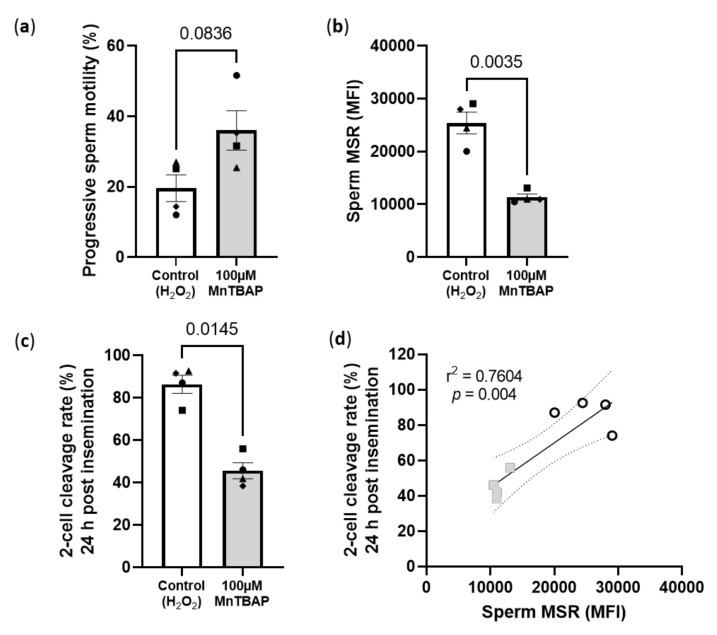Figure 3.
Reducing sperm mitochondrial superoxide concentrations with 100 µM MnTBAP in a mouse model of in vitro H2O2 exposure significantly impairs 2-cell embryo development. (a) Proportion of sperm with progressive motility; (b) Sperm mitochondrial superoxide mean fluorescence intensity (MFI) (MitoSox Red, (MSR) a specific mitochondrial superoxide indicator); (c) Proportion of 2-cells 24 h post insemination with 10,000 sperm and (d) Linear regression of sperm superoxide concentrations and 2-cell cleavage rates (grey squares: 100 µM MnTBAP, white circles: 3000 µM H2O2). Data is representative of 4 CBAF1 males (represented by different symbols on graphs) and 24 super ovulated 3–4 weeks old CBAF1 females. Female mice were super ovulated with 5IU of PMSG followed 48 h with 5IU of HCG. Sperm was collected from male mice 15 h post HCG and incubated in 3000 µM of H2O2 in G-IVF PLUS (Vitrolife) for 1 h at 37 °C, 5% O2 and 6% CO2. Sperm samples were split into two groups and either incubated in (1) Control: 3000 µM of H2O2 in G-IVF PLUS or (2) 100 µM of MnTBAP: 3000 µM of H2O2 in G-IVF PLUS for a further 1 h at 37 °C, 5% O2 and 6% CO2. Cumulus oocyte complexes (COC) were collected from female mice 15.5 h post HCG. Sperm were washed of their treatments after backfilling with 3 mL of G-IVF PLUS by centrifugation 400× g for 5 min. COCs were inseminated with 10,000 sperm 16.5 h post HCG. Following a 4 h fertilization, zygotes were washed and cultured in G1 PLUS (Vitrolife) for 24 h at 37 °C, 5% O2 and 6% CO2 at which 2-cell embryo cleavage rates were assessed. Prior to insemination, sperm progressive motility was assessed in 200 sperm per sample and superoxide concentrations assessed after 30 min incubation at 37 °C of 5µM of MSR and 10,000 sperm assessed on a FACS Canto II. Data was analysed by a paired t-test or a simple linear regression showing the slope and 95% confidence intervals.

